Monitoring Green Infrastructure for Natural Water Retention Using Copernicus Global Land Products
Abstract
:1. Introduction
- Store carbon, reduce greenhouse gas emissions, and lower the carbon footprint due to residential, transport and energy production sectors, as well as alleviate extreme weather events and natural disasters, thus supporting the EU Strategy on Adaptation to Climate Change [17].
- Avoid forest erosion, soil contamination, and the fragmentation and degradation of ecosystems, as required by the EU Forests Strategy [20].
- Achieve several objectives of the Common Agricultural Policy (CAP) [21] and encourage agricultural sustainable practices.
- Improve water quality and storage, treat waste water, reduce hydro-morphological pressures on river basins, and mitigate the impacts of floods and droughts, thus contributing to the goals of all EU water-related policies, including the Water Framework Directive [22], the Groundwater Directive [23], and the Floods Directive [24].
2. Materials and Methods
2.1. Catalogue
2.2. Research Works Using Bio-Geophysical Indices
2.2.1. CGLS Vegetation and Energy Products
2.2.2. Literature Review
- Study natural water retention measures (NWRMs).
- Monitor their biophysical impacts (BPs).
- Observe the delivery of NWRM-linked ecosystem services (ESs).
- Assess the achievement of NWRM-related policy objectives (POs) expressed by EU directives and strategies.
2.3. Quality of CGLS Products
2.4. Diagrams
2.4.1. Sankey Diagrams
2.4.2. User-Friendly Flowcharts
3. Results
3.1. Interpreting the Sankey Diagrams
- Which NWRMs or benefits (Table 1 and Table 2) have been successfully connected to the greatest number of bio-geophysical indices. This information can be ascertained from the widths of the diagram’s nodes of the leftmost column. In this specific diagram, the agriculture NWRMs that were suitably highlighted using most of the CGLS indices are meadows and pastures (A1) and crop rotation (A3), while solely two links and just with vegetation indices were found for strip cropping along contours (A4) and controlled traffic farming (A11).
- Which CGLS vegetation indices have been used to identify and monitor the greatest number of NWRMs and benefits. The width of the green nodes of the second column, which depends on the number of connections to the nodes of the first column (i.e., how many NWRM or benefits each bio-geophysical index can actually or potentially study, according to the scientific literature), communicates this information.In this diagram, the normalized difference vegetation index (NDVI) and the leaf area index (LAI) are the vegetation indices showing the largest number of links to agriculture NWRMs and hence the greatest width, which implies they are capable of studying a wider variety of agriculture NWRMs. They are followed by the fraction of vegetation cover (FCOVER) and the dry matter productivity (DMP)/gross dry matter productivity (GDMP). The burned area and soil water index (SWI) are the least used vegetation indices.
- The most used CGLS energy indices. The width of the red nodes of the second column, which depends again on the number of linking lines leading to them and hence on the indices’ suitability to monitor the NWRM or benefits in the first column, conveys this information.In this case, top-of-canopy reflectance (TOCR) is the energy index with the largest width and thus is capable of monitoring more agriculture NWRMs, closely followed by surface albedo. On the other hand, land surface temperature (LST) appears as the least used energy index.
- The available versions (depending on the existing spatial resolutions) and the quality that users can expect when using the products. This information is shown in the third and fourth columns.Most of the products show a proper continuity along the globe with a minor amount of lost data, especially in Southern latitudes and during summertime, and a good temporal consistency for long-term analysis, with smooth temporal profiles (green lines). As for the spatial consistency, it is acceptable (yellow lines) for more than half of the products, with discrepancies when comparing values between homogeneous areas. Accuracy varies widely and has not been assessed for a significant number of product versions (Table 4). It is worth highlighting that the lines connecting the third and fourth columns are equivalent in all six Sankey diagrams.
3.2. Understanding the User-Friendly Flowcharts
4. Discussion
5. Conclusions
- Remotely-sensed satellite data keeps proving its high potential for monitoring the Earth, easing spatial planning and land use management tasks in large areas.
- The examined vegetation and energy bio-geophysical indices, freely provided by the Copernicus Global Land Service (CGLS) products, are able to monitor most natural water retention measures (NWRMs) and their benefits, by which we mean NWRM biophysical impacts, delivered ecosystem services, and the accomplishment of NWRM-related policy objectives. Overall, the most suited vegetation indices are firstly the normalized difference vegetation index (NDVI) and secondly the leaf area index (LAI), while the most used energy index is top-of-canopy reflectance (TOCR).
- We can thus see that the apparently most useful indices are the older ones, which can be used in a wide variety of contexts. NDVI remains the most suitable index based on the literature review.
- Some newly-developed indices are also promising alternatives: The fraction of green vegetation cover (FCOVER), in particular, has shown its potential to replace or complement consolidated indices and we are implementing new research in that direction [78].
- Just 8 out of the 80 catalogued NWRMs and related benefits were not linked to any index, which shows the indices’ potential for testing real NWRM pilot cases, providing a first baseline that, combined with future multidisciplinary research, eases the successful implementation of the same or similar measures. This may be due to: (i) No studies having been carried out on that specific subject or (ii) no indices being actually capable of monitoring the item. Future research could focus on studying this issue in detail.
- Potential users should consider that the CGLS was not conceived as a database of complete and final products but as input data for researchers and institutions to develop new down-streaming services and evolve more detailed and scalable models, policies, strategies, planning, or management tools, with the aim of enhancing Earth monitoring and the detection of land changes and land uses, as well as assessing and encouraging the use of nature-based solutions for climate change adaptation.
- The developed Sankey diagrams and final user-friendly flowcharts will hence help GI users in their decision-making tasks, providing information on the most suitable indices (according to the scientific literature) to monitor both NWRMs and their benefits. Moreover, the diagrams indicate the quality and accuracy that the user can expect when downloading and using the CGLS products.
- The temporal coverage of the CGLS products is very competitive, particularly considering that most of them cover the globe every 10 days, surely fulfilling several users’ requirements on this regard, for any level of detail of their analyses. Also, most of the 1 km versions provide data from 1999, which allow studies using very long-term data series, also taking advantage of a good overall temporal consistency and data continuity along the globe, especially with almost no gaps during summertime and in Central and Southern latitudes. When instead analyzing data in Northern latitudes or wintertime, users should consider double-checking consecutive dates, homogeneous areas, and temporal profiles. Spatial consistency and accuracy should also be verified by the users, checking data from different sensors or for the same areas in several locations, since the reviewed technical documents show overall low, acceptable, or not-yet-assessed results for these two quality parameters.
- Since Copernicus aims to meet the needs for ecosystem analyses on a global scale coming from national and regional public agencies countries and political/economic unions, such as the USA and the EU, a global and systematic acquisition system (i.e., able to acquire the Earth surface almost continuously and systematically with very competitive spatial resolutions) is a fundamental requirement for the Copernicus evolution. Specifically, referring to the spatial resolution, our study highlights the need for the Copernicus program to develop 300 m versions of all global indices, as this would make them considerably more useful, at least for intra-national and global scale analyses of the provided data. A coarse spatial resolution is unfortunately a significant handicap (e.g., as proven for the TOCR product). Accuracy assessments should also be provided for all the product versions.
- The findings of this study are also valuable for the performance of a gap analysis between the available Copernicus products and operational user needs, as we are starting to work on [77]. Indeed, the European Commission has placed increasing interest in the collection of requirements to support the work of different institutional and private communities among the Member States. Thus, stakeholder needs, in terms of Copernicus products and services, can be identified through elicitation techniques and compared to the review hither performed in order to validate the information collected. This integration would provide the baseline not only for the advancement in technological provision, but also for the elaboration of policy recommendations in the domain of agriculture and environmental protection.
Author Contributions
Funding
Acknowledgments
Conflicts of Interest
Appendix A. Sankey Diagrams
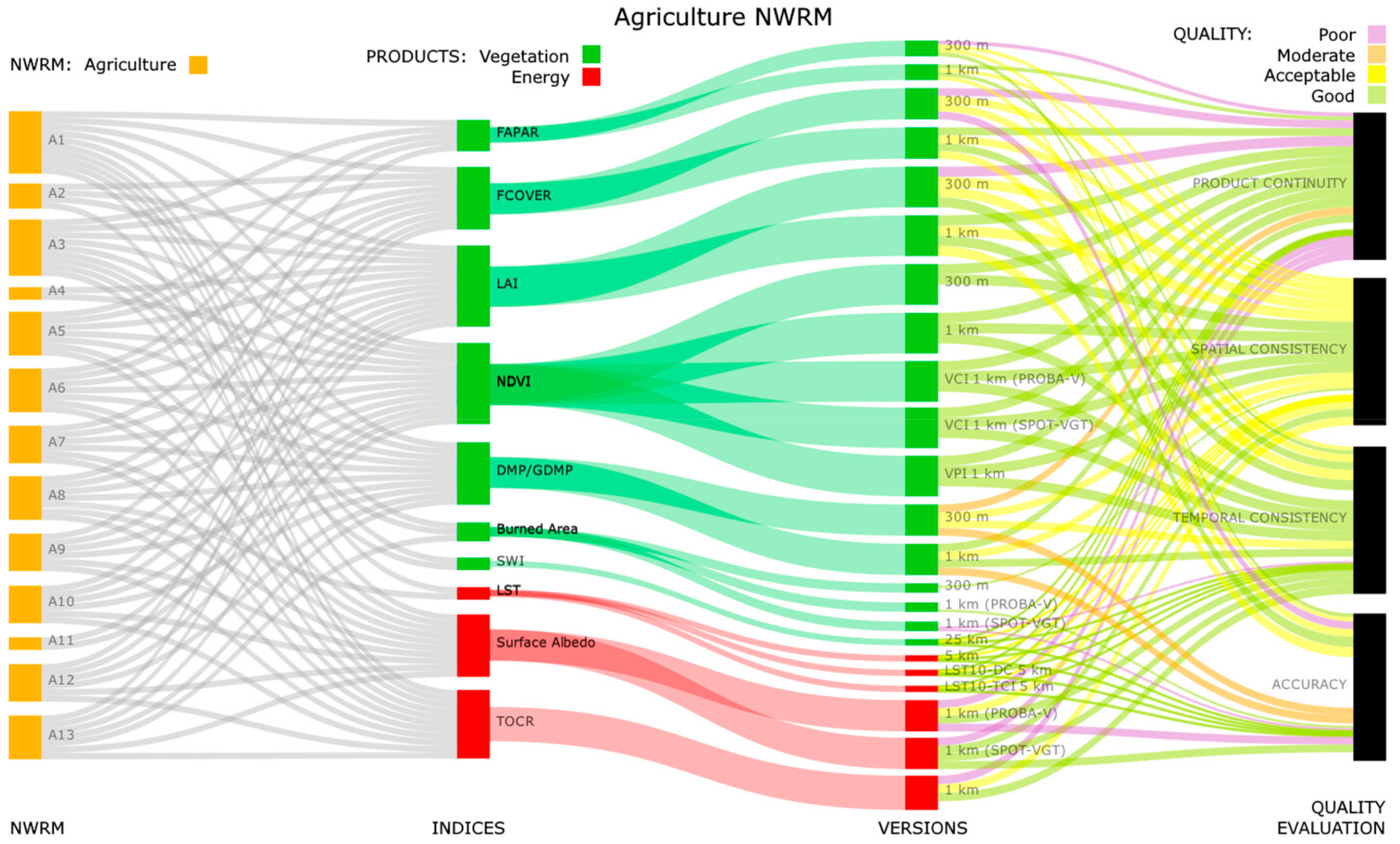
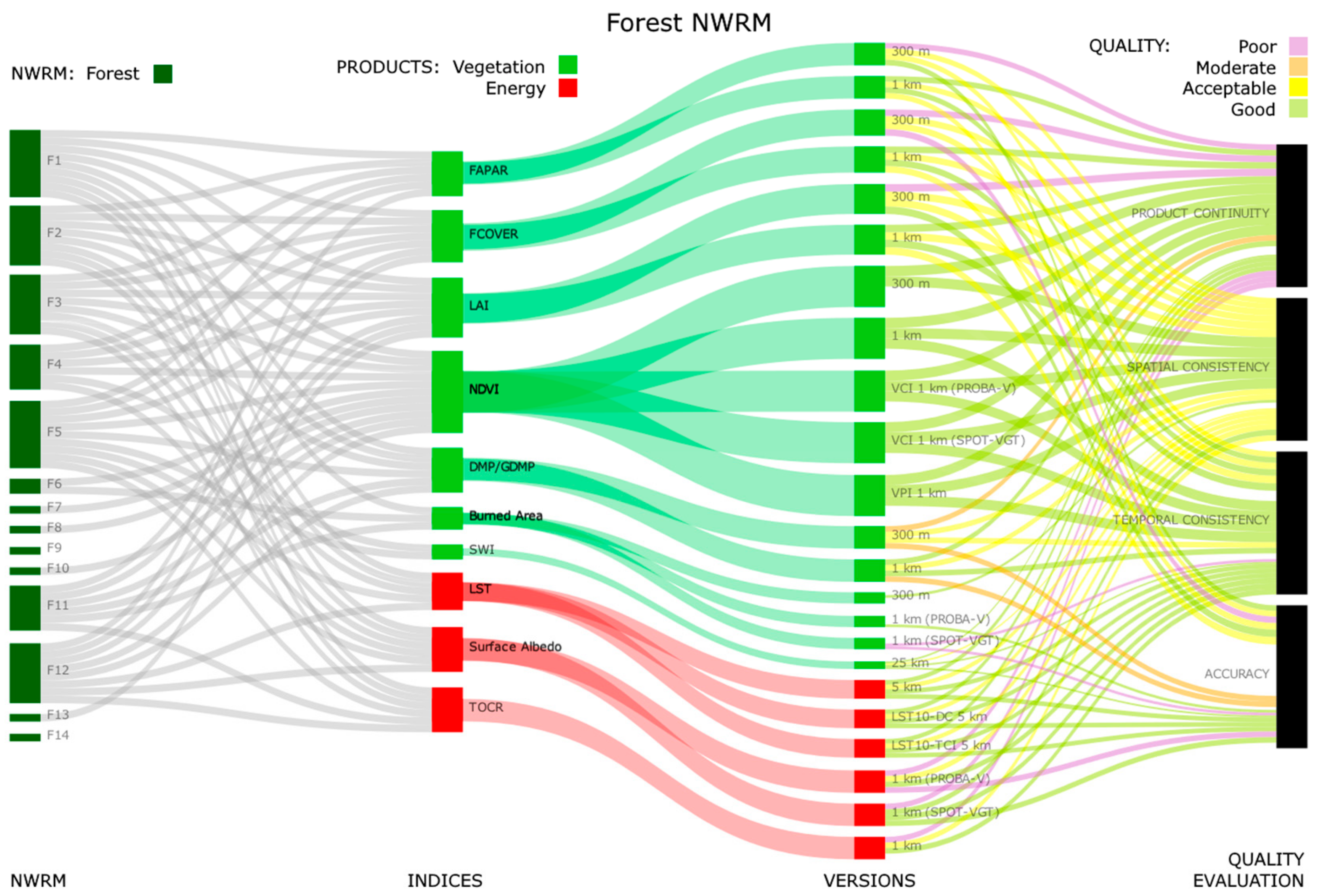
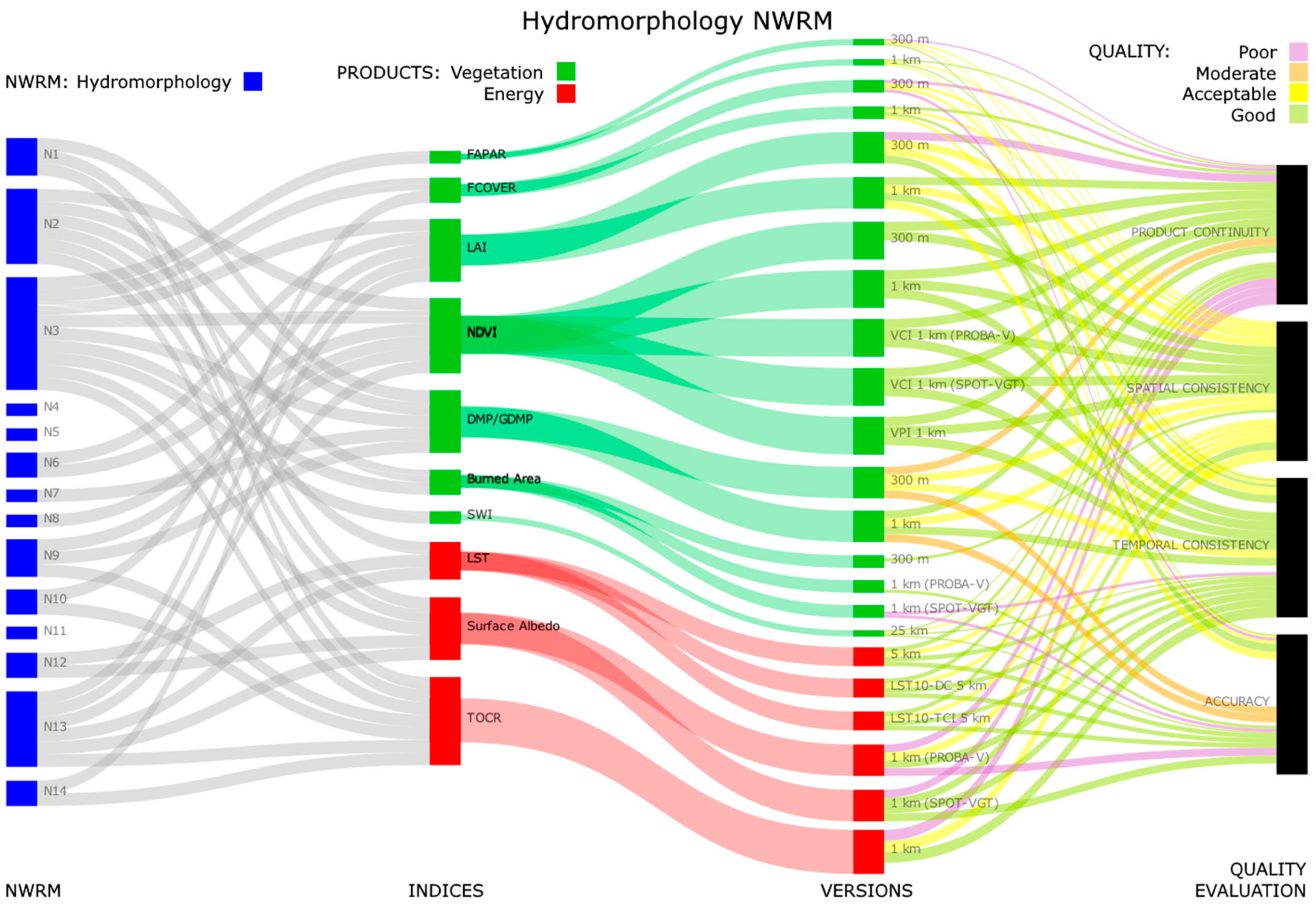
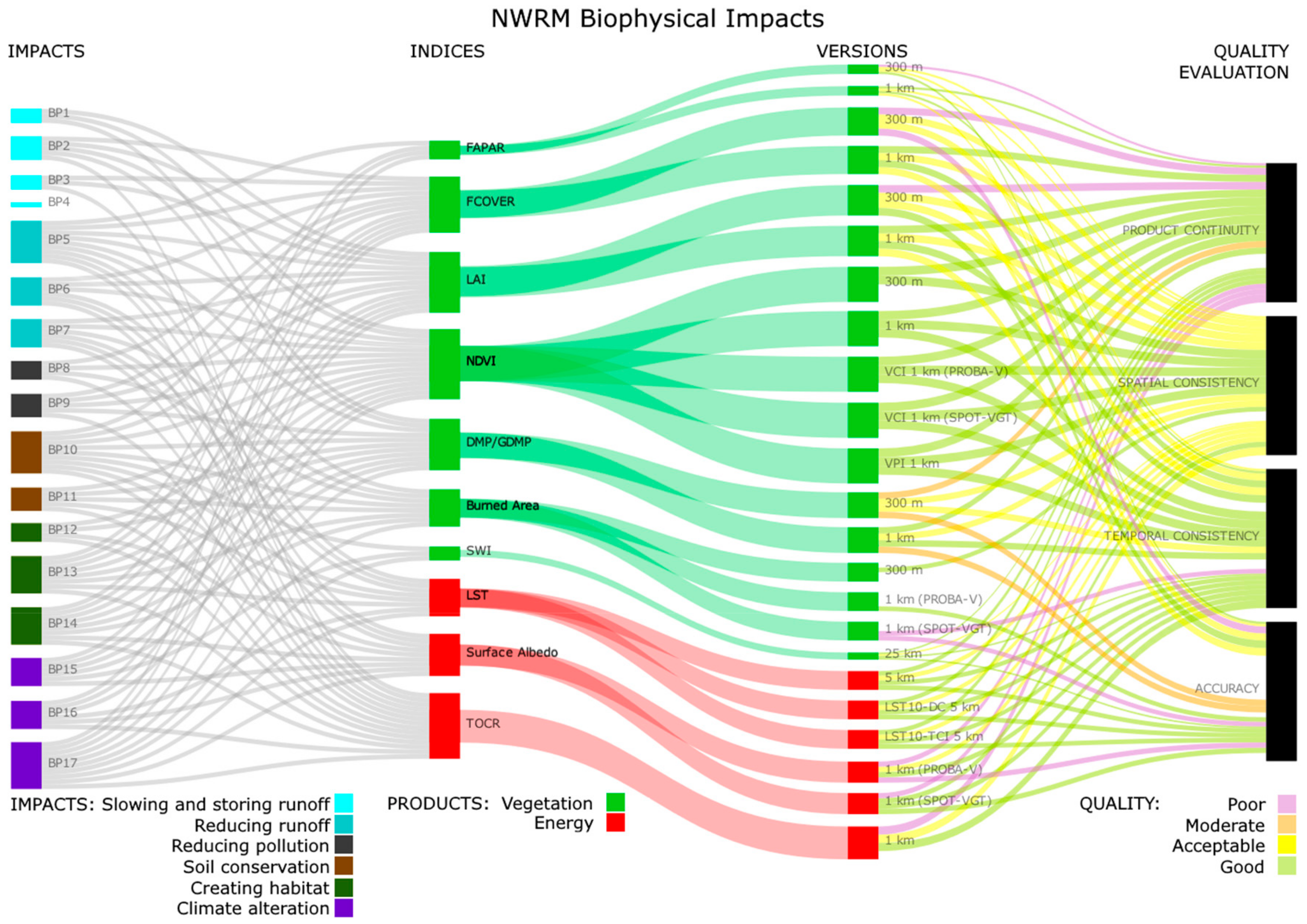
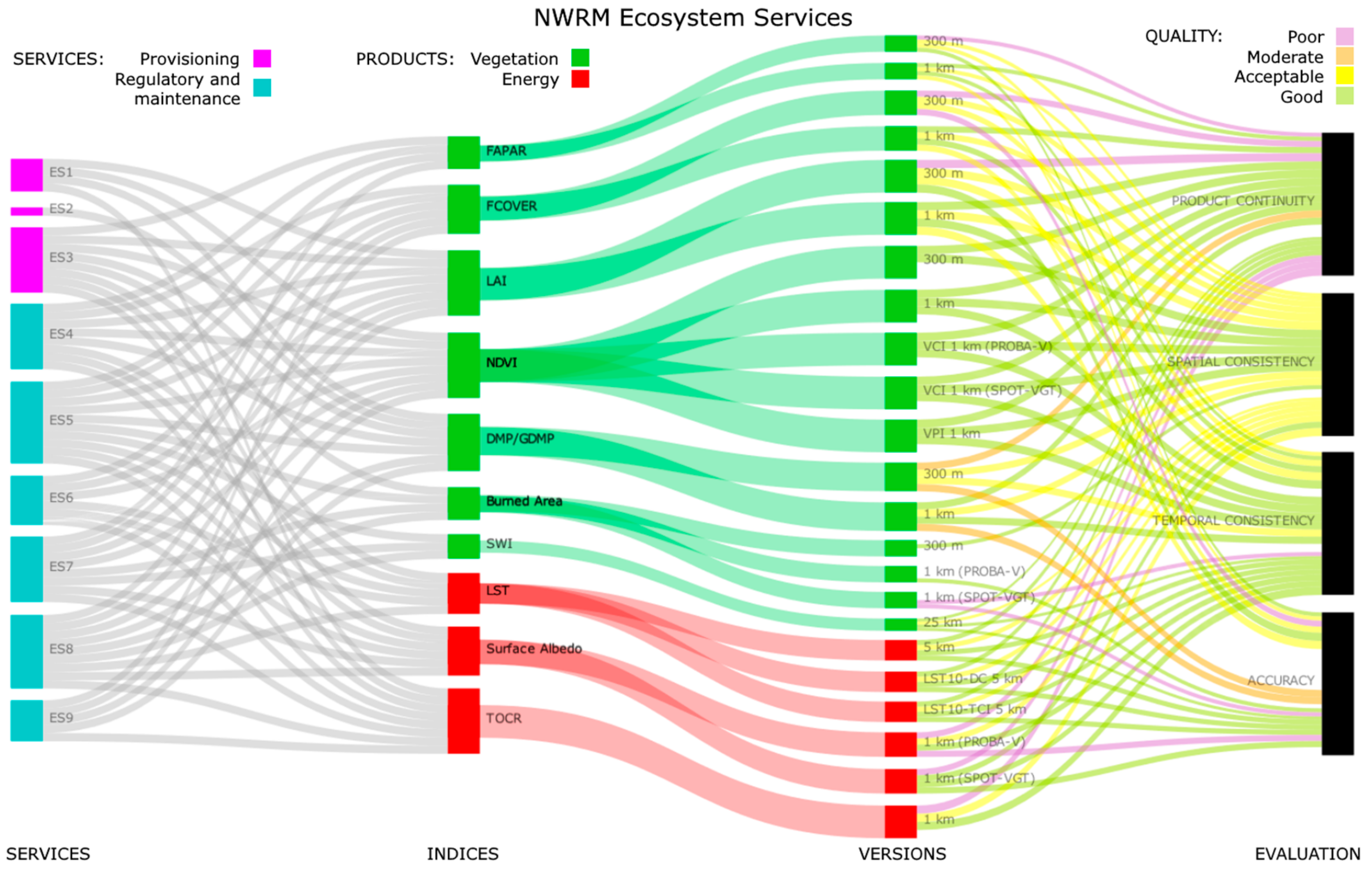
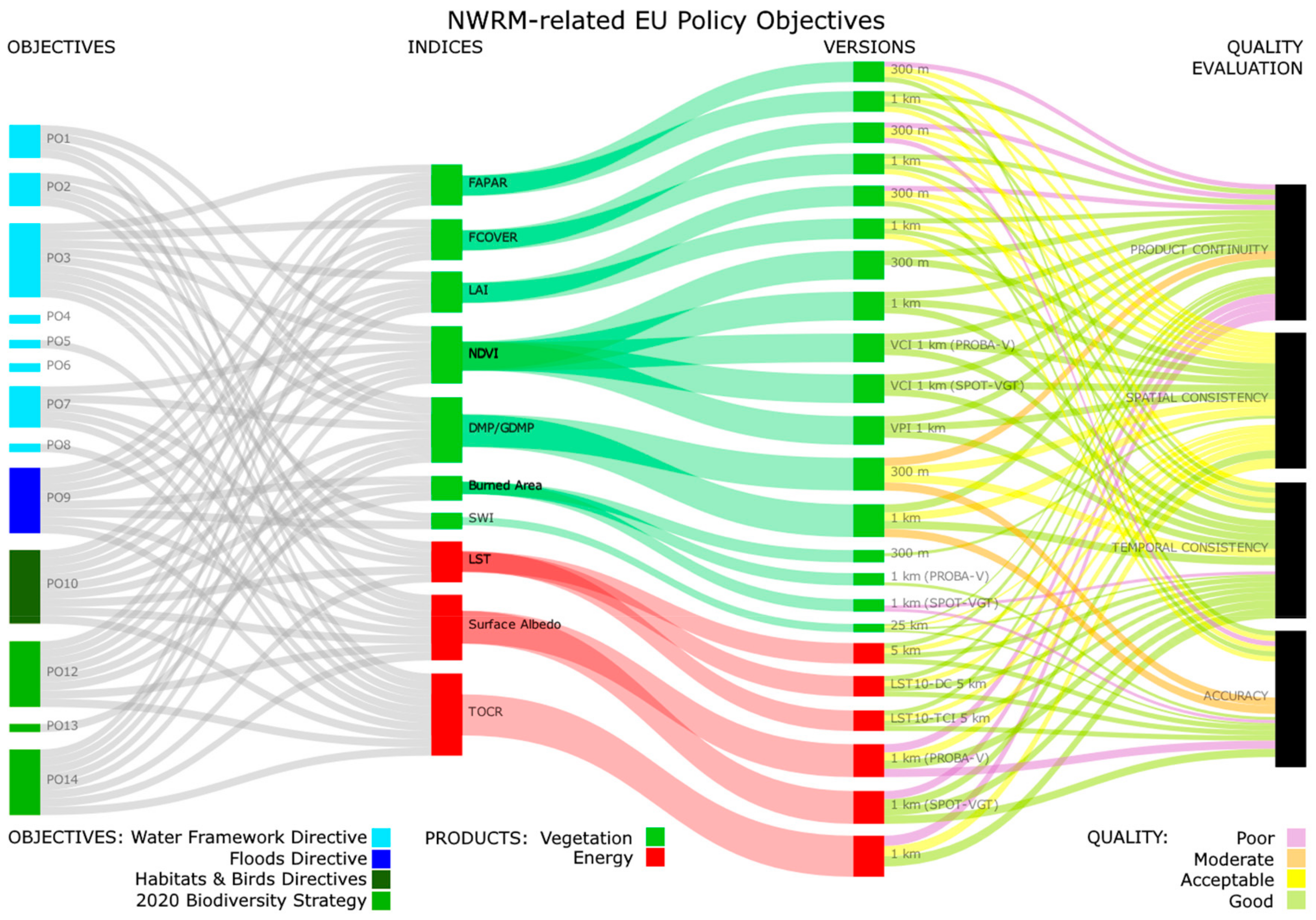
Appendix B. Decision Flowcharts
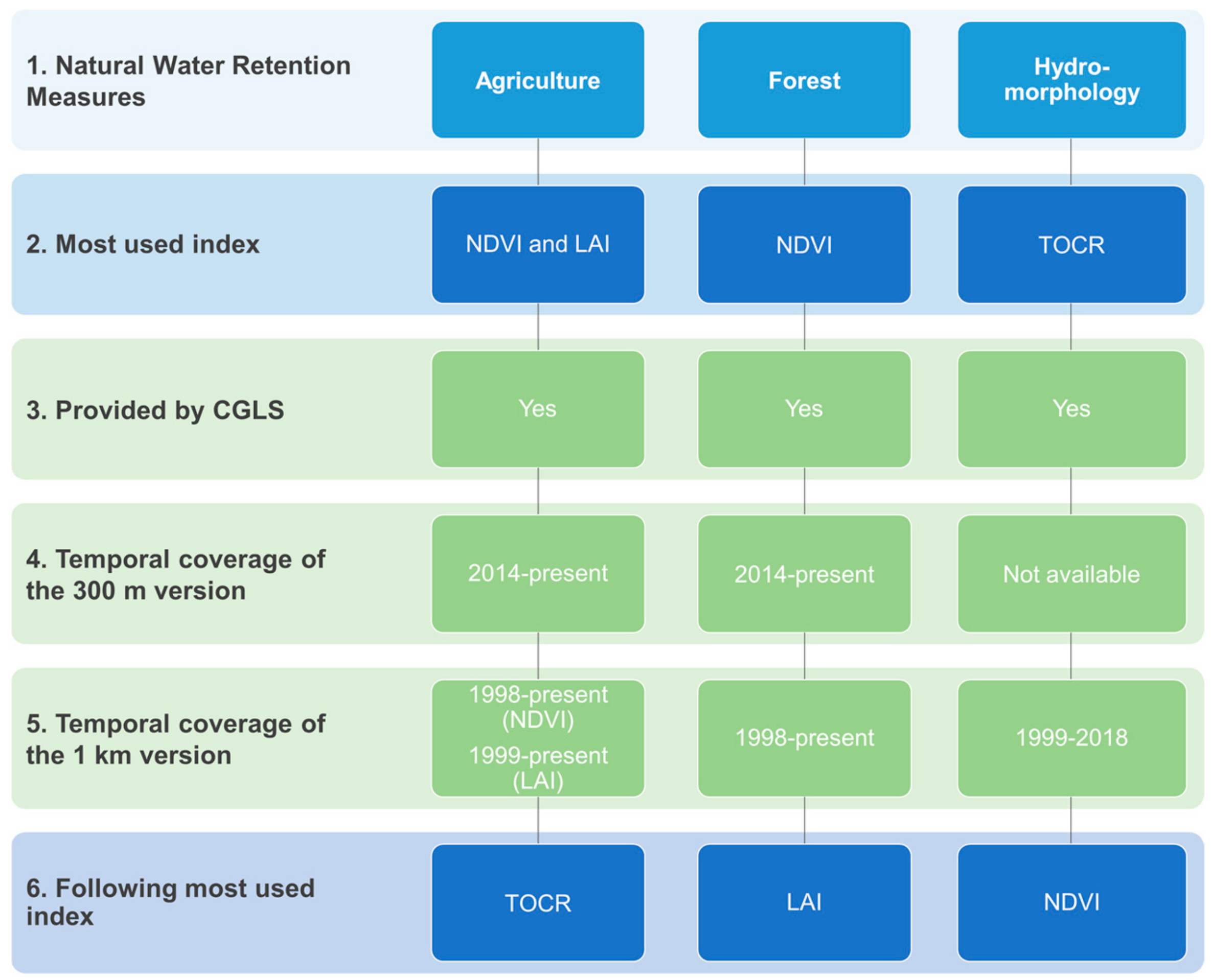

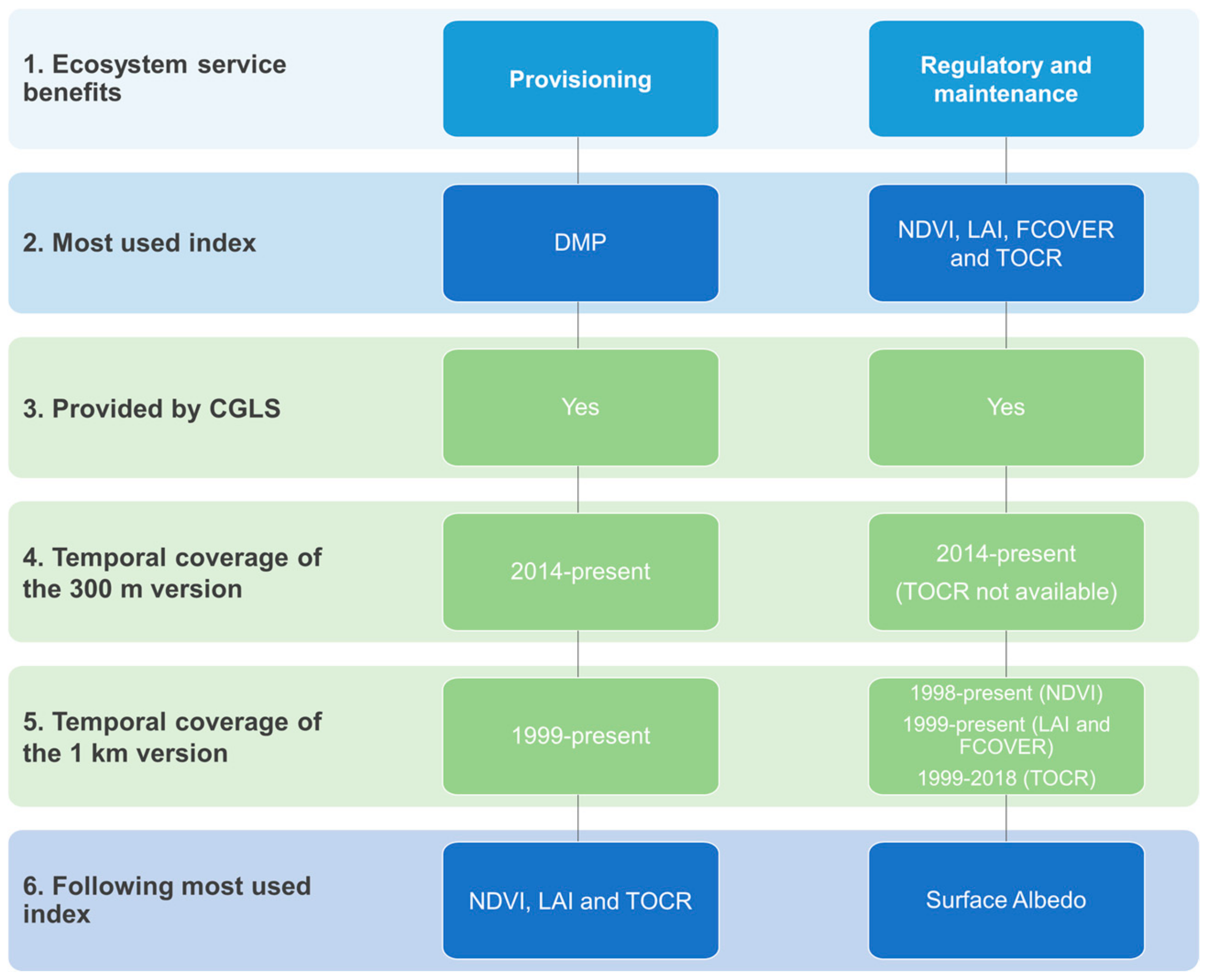
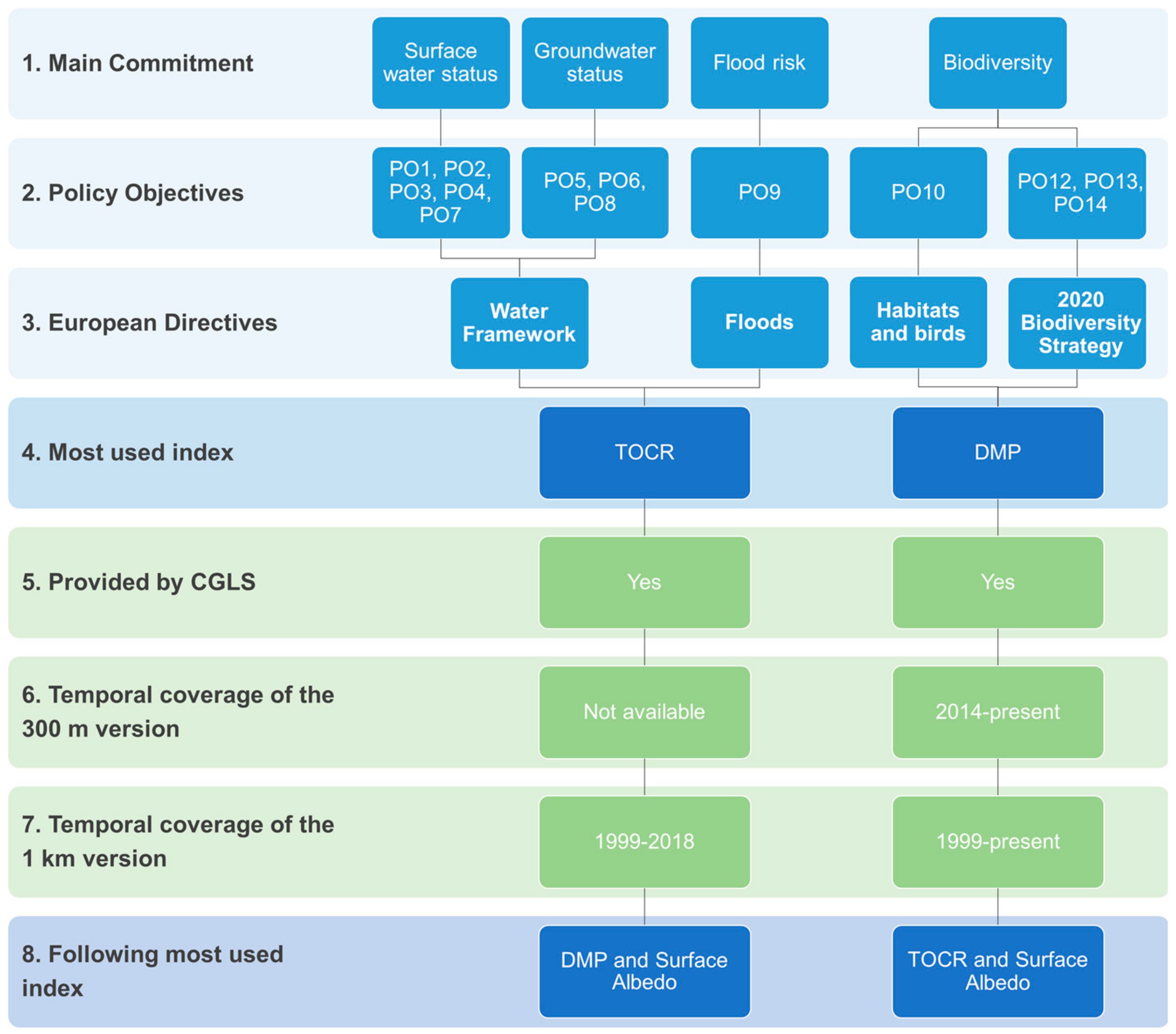
References
- Snäll, T.; Lehtomäki, J.; Arponen, A.; Elith, J.; Moilanen, A. Green Infrastructure Design Based on Spatial Conservation Prioritization and Modeling of Biodiversity Features and Ecosystem Services. Environ. Manag. 2016, 57, 251–256. [Google Scholar] [CrossRef] [PubMed]
- Cilliers, E.J. Reflecting on Green Infrastructure and Spatial Planning in Africa: The Complexities, Perceptions, and Way Forward. Sustainability 2019, 11, 455. [Google Scholar] [CrossRef]
- Artmann, M.; Kohler, M.; Meinel, G.; Gan, J.; Ioja, I.-C. How smart growth and green infrastructure can mutually support each other—A conceptual framework for compact and green cities. Ecol. Indic. 2019, 96, 10–22. [Google Scholar] [CrossRef]
- Evans, A.J.; Firth, L.B.; Hawkins, S.J.; Hall, A.E.; Ironside, J.E.; Thompson, R.C.; Moore, P.J. From ocean sprawl to blue-green infrastructure—A UK perspective on an issue of global significance. Environ. Sci. Policy 2019, 91, 60–69. [Google Scholar] [CrossRef]
- Lanzas, M.; Hermoso, V.; de-Miguel, S.; Bota, G.; Brotons, L. Designing a network of green infrastructure to enhance the conservation value of protected areas and maintain ecosystem services. Sci. Total Environ. 2019, 651, 541–550. [Google Scholar] [CrossRef]
- Lennon, M. Green infrastructure and planning policy: A critical assessment. Local Environ. 2015, 20, 957–980. [Google Scholar] [CrossRef]
- Maes, J.; Egoh, B.; Willemen, L.; Liquete, C.; Vihervaara, P.; Schägner, J.P.; Grizzetti, B.; Drakou, E.G.; La Notte, A.; Zulian, G.; et al. Mapping ecosystem services for policy support and decision making in the European Union. Ecosyst. Serv. 2012, 1, 31–39. [Google Scholar] [CrossRef]
- Maes, J.; Hauck, J.; Paracchini, M.L.; Ratamäki, O.; Hutchins, M.; Termansen, M.; Furman, E.; Pérez-Soba, M.; Braat, L.; Bidoglio, G. Mainstreaming ecosystem services into EU policy. Environ. Sustain. 2013, 5, 128–134. [Google Scholar] [CrossRef]
- European Commission. Communication from the Commission to the European Parliament, the Council, the European Economic and Social Committee and the Committee of the Regions; Green Infrastructure (GI)—Enhancing Europe’s Natural Capital, COM/2013/0249; European Commission: Brussels, Belgium, 2013. [Google Scholar]
- Hansen, R.; Olafsson, A.S.; van der Jagt, A.P.N.; Rall, E.; Pauleit, S. Planning multifunctional green infrastructure for compact cities: What is the state of practice? Ecol. Indic. 2019, 96, 99–110. [Google Scholar] [CrossRef]
- Valentini, E.; Filipponi, F.; Nguyen Xuan, A.; Passarelli, F.M.; Taramelli, A. Earth Observation for Maritime Spatial Planning: Measuring, Observing and Modeling Marine Environment to Assess Potential Aquaculture Sites. Sustainability 2016, 8, 519. [Google Scholar] [CrossRef]
- Cardoso da Silva, J.M.; Wheeler, E. Ecosystems as infrastructure. Perspect. Ecol. Conserv. 2017, 15, 32–35. [Google Scholar] [CrossRef]
- Suškevičs, M. Legitimate planning processes or informed decisions? Exploring public officials’ rationales for participation in regional green infrastructure planning in Estonia. Environ. Policy Gov. 2019, 29, 132–143. [Google Scholar] [CrossRef]
- Vallecillo, S.; Polce, C.; Barbosa, A.; Perpiña Castillo, C.; Vandecasteele, I.; Rusch, G.M.; Maes, J. Spatial alternatives for Green Infrastructure planning across the EU: An ecosystem service perspective. Landsc. Urban Plan. 2018, 174, 41–54. [Google Scholar] [CrossRef]
- Schindler, S.; Sebesvari, Z.; Damm, C.; Euller, K.; Mauerhofer, V.; Schneidergruber, A.; Biró, M.; Essl, F.; Kanka, R.; Lauwaars, S.G.; et al. Multifunctionality of floodplain landscapes: Relating management options to ecosystem services. Landsc. Ecol. 2014, 29, 229–244. [Google Scholar] [CrossRef]
- European Commission. Communication from the Commission to the European Parliament, the Council, the Economic and Social Committee and the Committee of the Regions; Our Life Insurance, Our Natural Capital: An EU Biodiversity Strategy to 2020, COM/2011/0244; European Commission: Brussels, Belgium, 2011. [Google Scholar]
- European Commission. Communication from the Commission to the European Parliament, the Council, the European Economic and Social Committee and the Committee of the Regions; An EU Strategy on Adaptation to Climate Change, COM/2013/0216; European Commission: Brussels, Belgium, 2013. [Google Scholar]
- European Commission. Council Directive 92/43/EEC of 21 May 1992 on the Conservation of Natural Habitats and of Wild Fauna and Flora; Official Journal L 206, 22/07/1992, 7–50; European Commission: Brussels, Belgium, 1992. [Google Scholar]
- European Commission. Directive 2009/147/EC of the European Parliament and of the Council of 30 November 2009 on the Conservation of Wild Birds; Official Journal L 20, 26/01/2010, 7–25; European Commission: Brussels, Belgium, 2010. [Google Scholar]
- European Commission. Communication from the Commission to the European Parliament, the Council, the European Economic and Social Committee and the Committee of the Regions; A New EU Forest Strategy: For Forests and the Forest-Based Sector, COM/2013/0659; European Commission: Brussels, Belgium, 2013. [Google Scholar]
- Common Agricultural Policy. Available online: https://ec.europa.eu/info/food-farming-fisheries/key-policies/common-agricultural-policy_en (accessed on 28 June 2018).
- European Commission. Directive 2000/60/EC of the European Parliament and of the Council of 23 October 2000 Establishing a Framework for Community Action in the Field of Water Policy; Official Journal L 327, 22/12/2000, 1–73; European Commission: Brussels, Belgium, 2000. [Google Scholar]
- European Commission. Directive 2006/118/EC of the European Parliament and of the Council of 12 December 2006 on the protection of groundwater against pollution and deterioration; Official Journal L 372, 27/12/2006, 19–31; European Commission: Brussels, Belgium, 2006. [Google Scholar]
- European Commission. Directive 2007/60/EC of the European Parliament and of the Council of 23 October 2007 on the Assessment and Management of Flood Risks; Official Journal L 288, 6/11/2007, 27–34; European Commission: Brussels, Belgium, 2007. [Google Scholar]
- Cools, J.; Strosser, P.; Achilleos, E.; Borchers, T.; Ochs, S.; Borchmann, A.; Steinmann, E.; Bussettini, M.; Gentili, M.M.; Gigliani, F.; et al. EU Policy Document on Natural Water Retention Measures; Technical Report; European Commission: Brussels, Belgium, 2014. [Google Scholar]
- Strosser, P.; Delacámara, G.; Hanus, A.; Williams, H.; Jaritt, N. A Guide to Support the Selection, Design and Implementation of Natural Water Retention Measures in Europe—Capturing the Multiple Benefits of Nature-Based Solutions, Final version, April 2015, Directorate—General for Environment; European Commission: Brussels, Belgium, 2016. [Google Scholar]
- Taramelli, A.; Valentini, E.; Cornacchia, L.; Bozzeda, F. A Hybrid Power Law Approach for Spatial and Temporal Pattern Analysis of Salt Marsh Evolution. J. Coast. Res. 2017, 77, 62–72. [Google Scholar] [CrossRef] [Green Version]
- European Commission. Directorate-General Environment. Towards Better Environmental Options for Flood Risk Management; Note by DG-ENV D.1. 2011/236452; European Commission: Brussels, Belgium, 2011. [Google Scholar]
- Pilot Project—Atmospheric Precipitation—Protection and Efficient Use of Fresh Water, Integration of Natural Water Retention Measures in River Basin Management. European Commission Directorate-General for Environment DG-ENV, 07.0330/2013/659147/SER/ENV.C1, 05/09/2013 to 05/11/2014. Available online: http://nwrm.eu/ (accessed on 16 July 2018).
- European Commission. Regulation (EU) No 377/2014 of the European Parliament and of the Council of 3 April 2014 Establishing the Copernicus Programme and Repealing Regulation (EU) No 911/2010 (Text with EEA Relevance). Journal L 122, 24/04/2014, 44–66; European Commission: Brussels, Belgium, 2014. [Google Scholar]
- Davies, C.; Lafortezza, R. Transitional path to the adoption of nature-based solutions. Land Use Policy 2019, 80, 406–409. [Google Scholar] [CrossRef]
- Tudorie, C.M.; Gielen, E.; Vallés-Planells, M.; Galiana, F. Urban green indicators: A tool to estimate the sustainability of our cities. Int. J. Des. Nat. Ecodyn. 2019, 14, 19–29. [Google Scholar] [CrossRef]
- Piedelobo, L.; Hernández-López, D.; Ballesteros, R.; Chakhar, A.; Del Pozo, S.; González-Aguilera, D.; Moreno, M.A. Scalable pixel-based crop classification combining Sentinel-2 and Landsat-8 data time series: Case study of the Duero river basin. Agric. Syst. 2019, 171, 36–50. [Google Scholar] [CrossRef]
- Filipponi, F.; Valentini, E.; Nguyen Xuan, A.; Guerra, C.A.; Wolf, F.; Andrzejak, M.; Taramelli, A. Global MODIS Fraction of Green Vegetation Cover for Monitoring Abrupt and Gradual Vegetation Changes. Remote Sens. 2018, 10, 653. [Google Scholar] [CrossRef]
- Murray, N.J.; Keith, D.A.; Bland, L.M.; Ferrari, R.; Lyons, M.B.; Lucas, R.; Pettorelli, N.; Nicholson, E. The role of satellite remote sensing in structured ecosystem risk assessments. Sci. Total Environ. 2018, 619–620, 249–257. [Google Scholar] [CrossRef]
- Piedelobo, L.; Ortega-Terol, D.; del Pozo, S.; Hernández-López, D.; Ballesteros, R.; Moreno, M.A.; Molina, J.-L.; González-Aguilera, D. HidroMap: A New Tool for Irrigation Monitoring and Management Using Free Satellite Imagery. ISPRS Int. J. Geo-Inf. 2018, 7, 220. [Google Scholar] [CrossRef]
- Bannari, A.; Morin, D.; Bonn, F.; Huete, A.R. A review of vegetation indices. Remote Sens. Rev. 1995, 13, 95–120. [Google Scholar] [CrossRef]
- Xue, J.; Su, B. Significant Remote Sensing Vegetation Indices: A Review of Developments and Applications. J. Sens. 2017, 1, 1–17. [Google Scholar] [CrossRef]
- Marando, F.; Salvatori, E.; Sebastiani, A.; Fusaro, L.; Manes, F. Regulating Ecosystem Services and Green Infrastructure: Assessment of Urban Heat Island effect mitigation in the municipality of Rome, Italy. Ecol. Model. 2019, 392, 92–102. [Google Scholar] [CrossRef]
- Copernicus Global Land Service. Providing Bio-Geophysical Products of Global Land Surface. Available online: https://land.copernicus.eu/global/index.html (accessed on 12 June 2018).
- GREEN Project—Green Infrastructures for Disaster Risk Reduction Protection: Evidence, Policy Instruments and Marketability. European Commission Directorate-General for European Civil Protection and Humanitarian Aid Operations DG-ECHO, ECHO/SUB/2016/740172/PREV18, 01/01/2017 to 31/12/2018. Available online: http://www.green-infrastructures.eu/ (accessed on 20 December 2018).
- Bjerklie, D.M.; Birkett, C.M.; Jones, J.W.; Carabajal, C.; Rover, J.A.; Fulton, J.W.; Garambois, P.-A. Satellite remote sensing estimation of river discharge: Application to the Yukon River Alaska. J. Hydrol. 2018, 561, 1000–1018. [Google Scholar] [CrossRef] [Green Version]
- Knipper, K.R.; Kustas, W.P.; Anderson, M.C.; Alfieri, J.G.; Prueger, J.H.; Hain, C.R.; Gao, F.; Yang, Y.; Mckee, L.G.; Nieto, H.; et al. Evapotranspiration estimates derived using thermal-based satellite remote sensing and data fusion for irrigation management in California vineyards. Irrig. Sci. 2018, 37, 431–449. [Google Scholar] [CrossRef]
- MODIS—Moderate-resolution Imaging Spectroradiometer. Available online: https://modis.gsfc.nasa.gov/ (accessed on 12 June 2018).
- LUCAS—Land Use and Land Cover Survey. Available online: https://ec.europa.eu/eurostat/statistics-explained/index.php/LUCAS_-_Land_use_and_land_cover_survey (accessed on 12 June 2018).
- Baret, F.; Weiss, M.; Lacaze, R.; Camacho, F.; Makhmara, H.; Pacholczyk, P.; Smets, B. GEOV1: LAI and FAPAR essential climate variables and FCOVER global time series capitalizing over existing products. Part1: Principles of development and production. Remote Sens. Environ. 2013, 137, 299–309. [Google Scholar] [CrossRef]
- Verger, A.; Baret, F.; Weiss, M. Near real-time vegetation monitoring at global scale. IEEE J. Sel. Top. Appl. Earth Obs. Remote Sens. 2014, 7, 3473–3481. [Google Scholar] [CrossRef]
- Camacho, F.; Cernicharo, J.; Lacaze, R.; Baret, F.; Weiss, M. GEOV1: LAI, FAPAR essential climate variables and FCOVER global time series capitalizing over existing products. Part 2: Validation and intercomparison with reference products. Remote Sens. Environ. 2013, 137, 310–329. [Google Scholar] [CrossRef]
- Toté, C.; Swinnen, E.; Sterckx, S.; Clarijs, D.; Quang, C.; Maes, R. Evaluation of the SPOT/VEGETATION Collection 3 reprocessed dataset: Surface reflectances and NDVI. Remote Sens. Environ. 2017, 201, 219–233. [Google Scholar] [CrossRef]
- Kogan, F.N. Remote sensing of weather impacts on vegetation in non-homogeneous areas. Int. J. Remote Sens. 1990, 11, 1405–1419. [Google Scholar] [CrossRef]
- Smets, B.; Eerens, H.; Jacobs, T.; Toté, C. Product User Manual—Vegetation Condition Index (VCI) and Vegetation Productivity Index (VPI). In GIO Global Land Component Lot I—Operation of the Global Land Component; GMES Initial Operations; Copernicus Global Land Service, European Commission: Brussels, Belgium, 2015. [Google Scholar]
- Sannier, C.A.D.; Taylor, J.C.; Du Plessis, W.; Campbell, K. Real-time vegetation monitoring with NOAA-AVHRR in Southern Africa for wildlife management and food security assessment. Int. J. Remote Sens. 1998, 19, 621–639. [Google Scholar] [CrossRef]
- Monteith, J.L. Solar Radiation and Productivity in Tropical Ecosystems. J. Appl. Ecol. 1972, 9, 747–766. [Google Scholar] [CrossRef]
- Padilla, M.; Olofsson, P.; Stehman, S.V.; Tansey, K.; Chuvieco, E. Stratification and sample allocation for reference burned area data. Remote Sens. Environ. 2017, 203, 240–255. [Google Scholar] [CrossRef]
- Padilla, M.; Stehman, S.V.; Chuvieco, E. Validation of the 2008 MODIS-MCD45 global burned area product using stratified random sampling. Remote Sens. Environ. 2014, 144, 187–196. [Google Scholar] [CrossRef]
- Padilla, M.; Stehman, S.V.; Ramo, R.; Corti, D.; Hantson, S.; Oliva, P.; Alonso-Canas, I.; Bradley, A.V.; Tansey, K.; Mota, B.; et al. Comparing the Accuracies of Remote Sensing Global Burned Area Products using Stratified Random Sampling and Estimation. Remote Sens. Environ. 2015, 160, 114–121. [Google Scholar] [CrossRef]
- Padilla, M.; Stehman, S.V.; Litago, J.; Chuvieco, E. Assessing the Temporal Stability of the Accuracy of a Time Series of Burned Area Products. Remote Sens. 2014, 6, 2050–2068. [Google Scholar] [CrossRef] [Green Version]
- Pekel, J.-F.; Cottam, A.; Gorelick, N.; Belward, A.S. High-resolution mapping of global surface water and its long-term changes. Nature 2016, 540, 418–422. [Google Scholar] [CrossRef]
- Tansey, K.; Gregoire, J.-M.; Stroppiana, D.; Sousa, A.; Silva, J.; Pereira, J.; Boschetti, L.; Maggi, M.; Brivio, P.A.; Fraser, R.; et al. Vegetation burning in the year 2000: Global burned area estimates from SPOT VEGETATION data. J. Geophys. Res. 2004, 109, D14. [Google Scholar] [CrossRef]
- Tansey, K.; Grégoire, J.-M.; Defourny, P.; Leigh, R.; Pekel, J.-F.; van Bogaert, E.; Bartholomé, E. A new, global, multi-annual (2000–2007) burnt area product at 1 km resolution. Geophys. Res. Lett. 2008, 35, 1–6. [Google Scholar] [CrossRef]
- Smith, R.; Adams, M.; Maier, S.; Craig, R.; Kristina, A.; Maling, I. Estimating the area of stubble burning from the number of active fires detected by satellite. Remote Sens. Environ. 2007, 109, 95–106. [Google Scholar] [CrossRef]
- FAO. Global Ecofloristic Zones Mapped by the United Nations Food and Agricultural Organization. 2000; Aaron, R., Gibbs, H.K., Eds.; FAO: Rome, Italy, 2008. [Google Scholar]
- Boschetti, L.; Roy, D.; Hoffmann, A.; Humber, M. MODIS Collection 5.1 Burned Area Product—MCD45. User’s Guide; Version 3.0.1. User Guide Ed.; Copernicus Global Land Service, European Commission: Brussels, Belgium, 2013. [Google Scholar]
- Albergel, C.; Rüdiger, C.; Pellarin, T.; Calvet, J.-C.; Fritz, N.; Froissard, F.; Suquia, D.; Petitpa, A.; Piguet, B.; Martin, E. From near-surface to root-zone soil moisture using an exponential filter: An assessment of the method based on in-situ observations and model simulations. Hydrol. Earth Syst. Sci. 2008, 12, 1323–1337. [Google Scholar] [CrossRef]
- Wagner, W.; Lemoine, G.; Rott, H. A Method for Estimating Soil Moisture from ERS Scatterometer and Soil Data. Remote Sens. Environ. 1999, 70, 191–207. [Google Scholar] [CrossRef]
- Freitas, S.C.; Trigo, I.F.; Macedo, J.; Barroso, C.; Silva, R.; Perdigão, R. Land Surface Temperature from multiple geostationary satellites. Int. J. Remote Sens. 2013, 34, 3051–3068. [Google Scholar] [CrossRef]
- Kogan, F.N. Operational Space Technology for Global Vegetation Assessment. Bull. Am. Meteorl. Soc. 2001, 82, 1949–1964. [Google Scholar] [CrossRef]
- Carrer, D.; Roujean, J.-L.; Meurey, C. Comparing Operational MSG/SEVIRI Land Surface Albedo Products From Land SAF with Ground Measurements and MODIS. IEEE. Trans. Geosci. Remote Sens. 2010, 48, 1714–1728. [Google Scholar] [CrossRef]
- Geiger, B.; Carrer, D.; Franchisteguy, L.; Roujean, J.-L.; Meurey, C. Land Surface Albedo Derived on a Daily Basis from Meteosat Second Generation Observations. IEEE. Trans. Geosci. Remote Sens. 2008, 46, 3841–3856. [Google Scholar] [CrossRef]
- Jentner, W.; Keim, D.A. Visualization and Visual Analytic Techniques for Patterns. In High-Utility Pattern Mining. Studies in Big Data; Fournier-Viger, P., Lin, J.W., Nkambou, R., Vo, B., Tseng, V., Eds.; Springer: Cham, Switzerland, 2019; Volume 51, pp. 303–337. [Google Scholar]
- Plotly. Modern Analytics Apps for the Enterprise. Available online: https://plot.ly/ (accessed on 3 September 2018).
- Immitzer, M.; Vuolo, F.; Atzberger, C. First Experience with Sentinel-2 Data for Crop and Tree Species Classifications in Central Europe. Remote Sens. 2016, 8, 166. [Google Scholar] [CrossRef]
- Inglada, J.; Arias, M.; Tardy, B.; Hagolle, O.; Valero, S.; Morin, D.; Dedieu, G.; Sepulcre, G.; Bontemps, S.; Defourny, P.; et al. Assessment of an Operational System for Crop Type Map Production Using High Temporal and Spatial Resolution Satellite Optical Imagery. Remote Sens. 2015, 7, 12356–12379. [Google Scholar] [CrossRef] [Green Version]
- Rouse, J.W.; Hass, R.H.; Schell, J.A.; Deering, D.W. Monitoring vegetation systems in the Great Plains with ERTS. In Third Earth Resources Technology Satellite-1 Symposium—Volume I: Technical Presentations; NASA SP-351; NASA: Washington, DC, USA, 1973; pp. 309–317. [Google Scholar]
- Zheng, H.; Li, Y.; Robinson, B.E.; Liu, G.; Ma, D.; Wang, F.; Lu, F.; Ouyang, Z.; Daily, G.C. Using ecosystem service trade-offs to inform water conservation policies and management practices. Front. Ecol. Environ 2016, 14, 527–532. [Google Scholar] [CrossRef]
- Tiwari, T.; Lundström, J.; Kuglerová, L.; Laudon, H.; Öhman, K.; Ågren, A.M. Cost of riparian buffer zones: A comparison of hydrologically adapted site-specific riparian buffers with traditional fixed widths. Water Resour. Res. 2016, 52, 1056–1069. [Google Scholar] [CrossRef] [Green Version]
- Tornato, A.; Valentini, E.; Nguyen Xuan, A.; Taramelli, A.; Schiavon, E. Assessment of User-Driven Requirements in term of Earth Observation Products and Applications for Institutional Operational Services. In AGU Fall Meeting Abstracts, Proceedings of the AGU Fall Meeting Washington, DC, USA, 10–14 December 2018; American Geophysical Union: Washington, DC, USA, 2018. [Google Scholar]
- Valentini, E.; Nguyen Xuan, A.; Filipponi, F.; Tornato, A.; De Peppo, M.; Taramelli, A. Pressures, Quality and Threats in European Protected Areas Evaluating Vegetation (FCover) Changes. In AGU Fall Meeting Abstracts, Proceedings of the AGU Fall Meeting, Washington, DC, USA, 10–14 December 2018; American Geophysical Union: Washington, DC, USA, 2018. [Google Scholar]

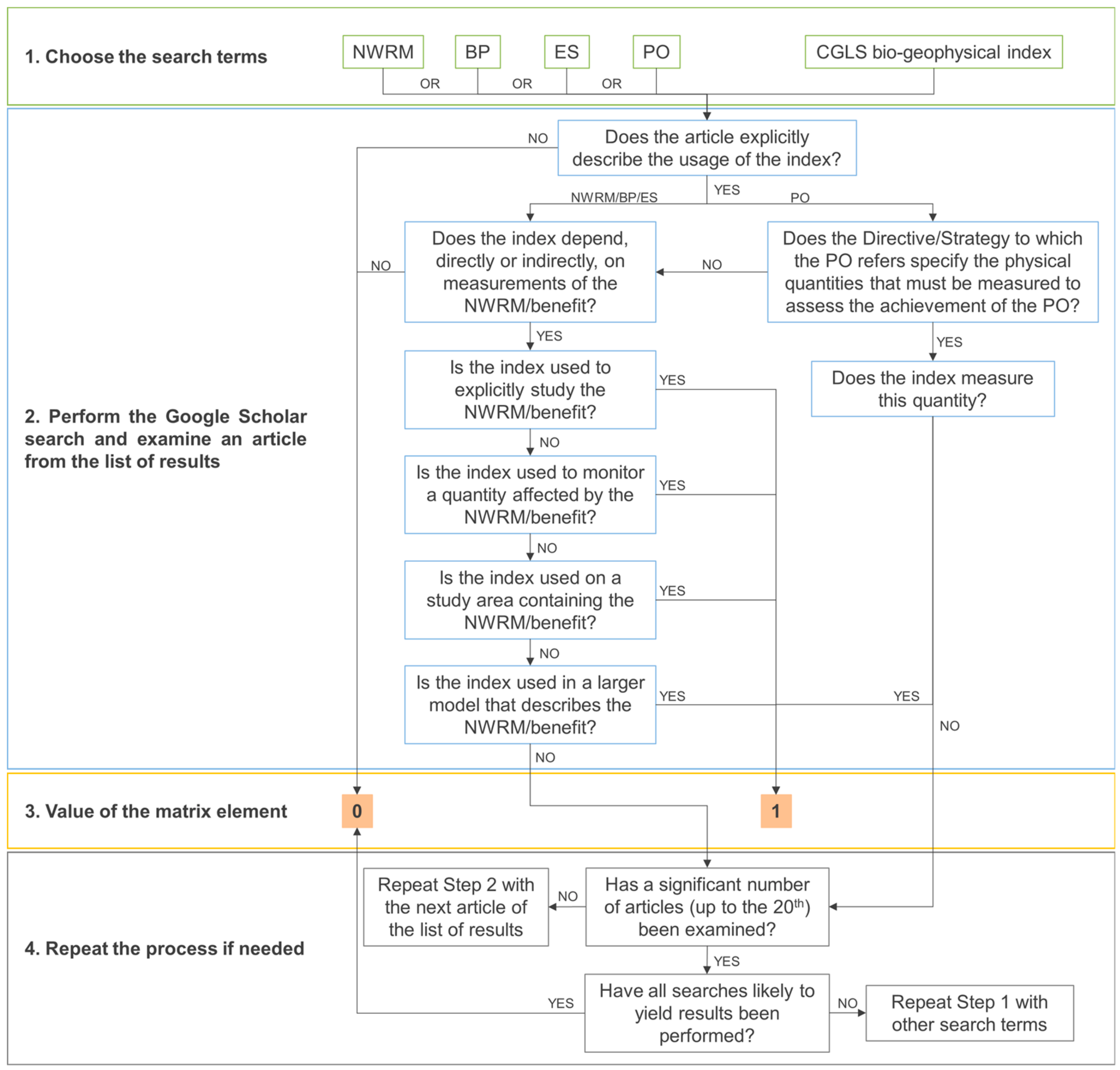
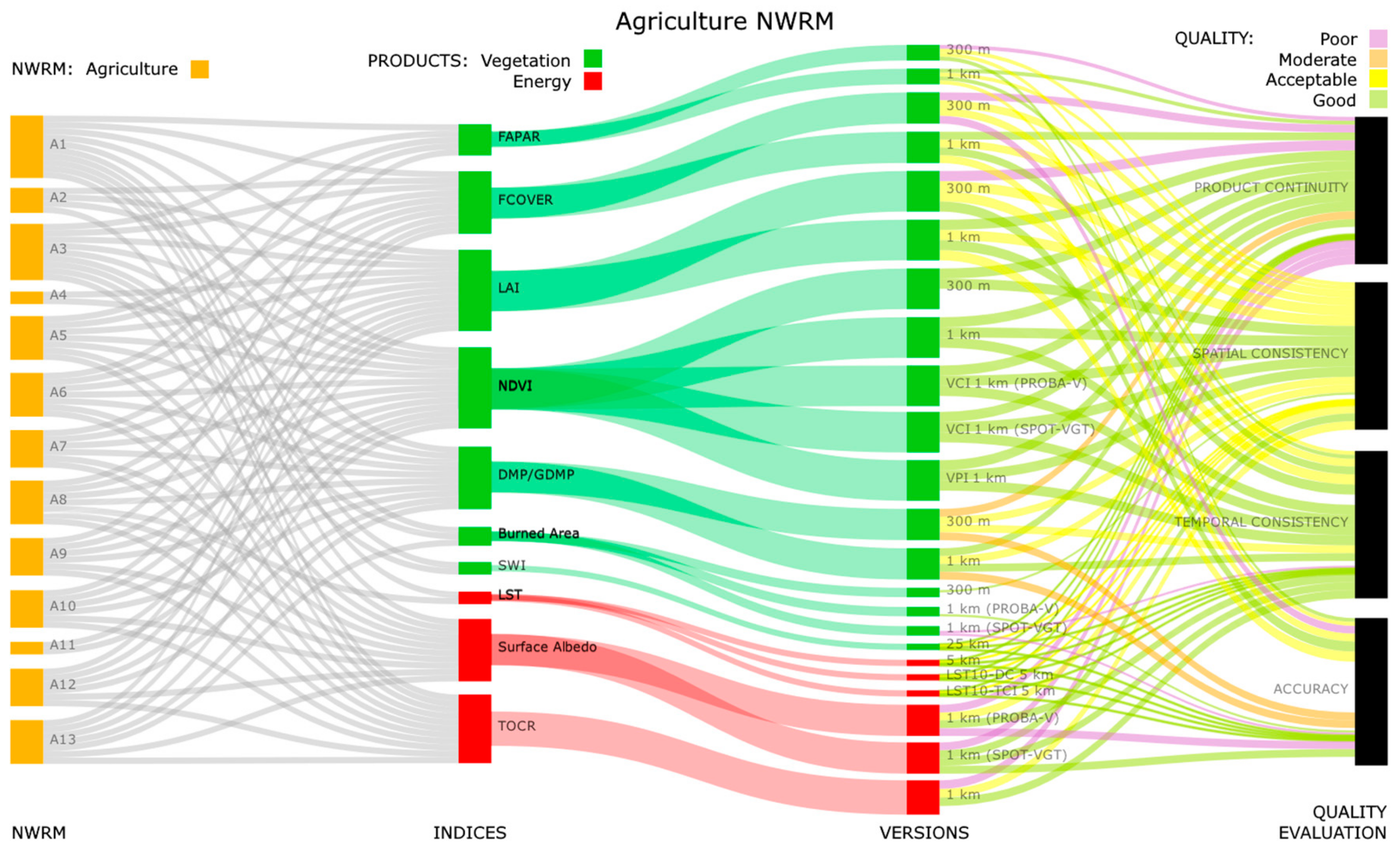
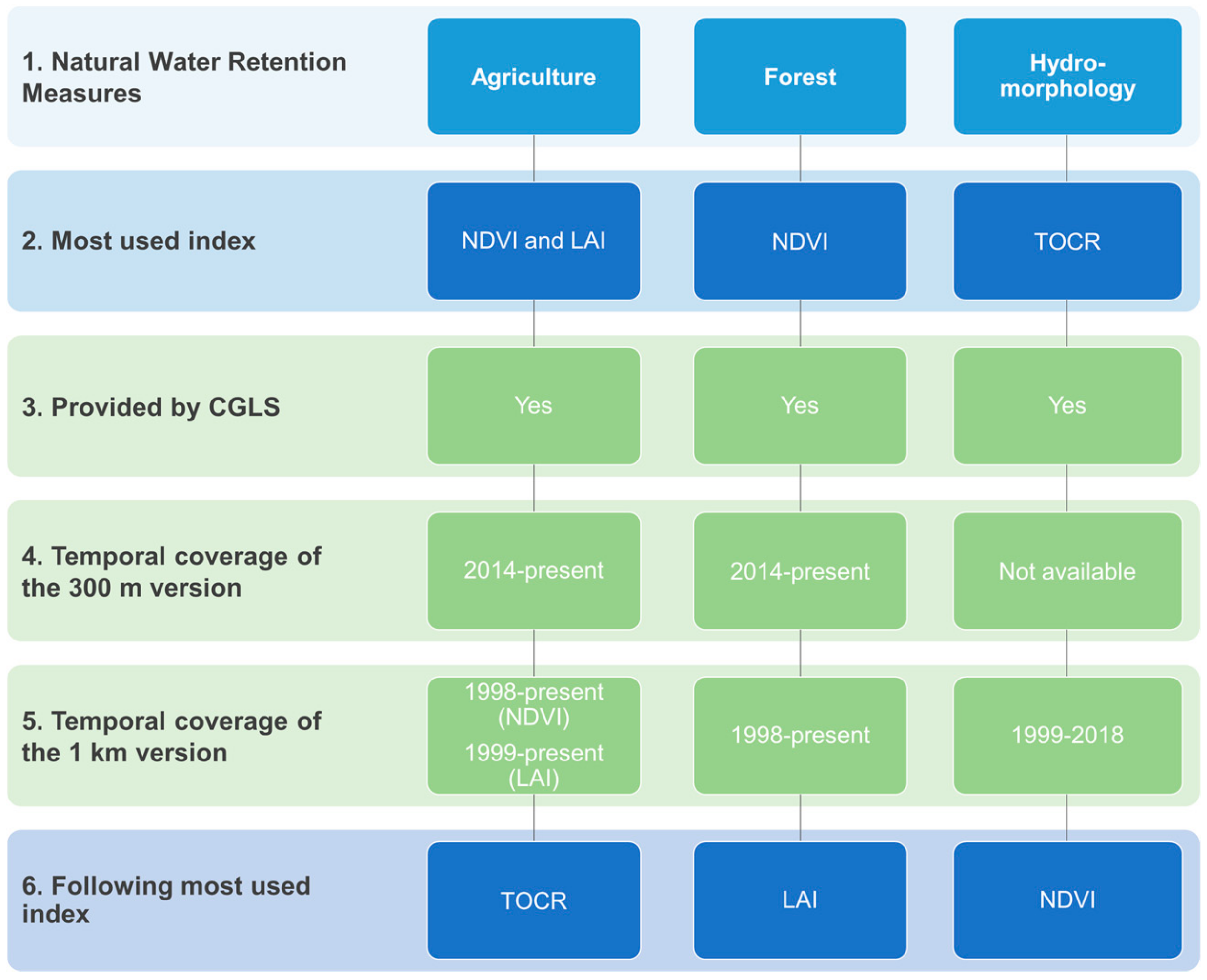
| Agriculture | Forest | Hydro-Morphology | |||
|---|---|---|---|---|---|
| A1 | Meadows and pastures | F1 | Forest riparian buffers | N1 | Basins and ponds |
| A2 | Buffer strips and hedges | F2 | Maintenance of forest cover in headwater areas | N2 | Wetland restoration and management |
| A3 | Crop rotation | F3 | Afforestation of reservoir catchments | N3 | Floodplain restoration and management |
| A4 | Strip cropping along contours | F4 | Targeted planting for catching precipitation | N4 | Re-meandering |
| A5 | Intercropping | F5 | Land use conversion | N5 | Stream bed re-naturalization |
| A6 | No till agriculture | F6 | Continuous cover forestry | N6 | Restoration and reconnection of seasonal streams |
| A7 | Low till agriculture | F7 | Water sensitive driving | N7 | Reconnection of oxbow lakes and similar features |
| A8 | Green cover | F8 | Appropriate design of roads and stream crossings | N8 | Riverbed material re-naturalization |
| A9 | Early sowing | F9 | Sediment capture ponds | N9 | Removal of dams and other longitudinal barriers |
| A10 | Traditional terracing | F10 | Coarse woody debris | N10 | Natural bank stabilization |
| A11 | Controlled traffic farming | F11 | Urban forest parks | N11 | Elimination of riverbank protection |
| A12 | Reduced stocking density | F12 | Trees in urban areas | N12 | Lake restoration |
| A13 | Mulching | F13 | Peak flow control structures | N13 | Restoration of natural infiltration to groundwater |
| F14 | Overland flow areas in peatland forests | N14 | Re-naturalization of polder areas | ||
| Biophysical Impacts | Ecosystem Services | Policy Objectives | |||
|---|---|---|---|---|---|
| BP1 | Store runoff | ES1 | Water storage | PO1 | Improving status of biology quality elements (WFD) |
| BP2 | Slow runoff | ES2 | Fish stocks and recruiting | PO2 | Improving status of physicochemical quality elements (WFD) |
| BP3 | Store river water | ES3 | Natural biomass production | PO3 | Improve status of hydro-morphology quality elements (WFD) |
| BP4 | Slow river water | ES4 | Biodiversity preservation | PO4 | Improve chemical status and priority substances (WFD) |
| BP5 | Increase evapotranspiration | ES5 | Climate change adaptation and mitigation | PO5 | Improve quantitative status (WFD) |
| BP6 | Increase infiltration and/or groundwater recharge | ES6 | Groundwater/aquifer recharge | PO6 | Improve chemical status (WFD) |
| BP7 | Increase soil water retention | ES7 | Flood risk reduction | PO7 | Prevent surface water status deterioration (WFD) |
| BP8 | Reduce pollutant sources | ES8 | Erosion/sediment control | PO8 | Prevent groundwater status deterioration (WFD) |
| BP9 | Intercept pollution pathways | ES9 | Filtration of pollutants | PO9 | Take adequate and coordinated measures to reduce flood risks (FD) |
| BP10 | Reduce erosion and/or sediment delivery | PO10 | Protection of important habitats (HD and BD) | ||
| BP11 | Improve soils | PO12 | More sustainable agriculture and forestry (BS) | ||
| BP12 | Create aquatic habitat | PO13 | Better management of fish stocks (BS) | ||
| BP13 | Create riparian habitat | PO14 | Prevention of biodiversity loss (BS) | ||
| BP14 | Create terrestrial habitat | ||||
| BP15 | Enhance precipitation | ||||
| BP16 | Reduce peak temperatures | ||||
| BP17 | Absorb and/or retain CO2 | ||||
| Index | Satellite Sensor | Spatial Resolution | Temporal Resolution | Temporal Coverage | Stage | |
|---|---|---|---|---|---|---|
| Vegetation | FAPAR | PROBA-V | 300 m | 10 days | 01/2014–present | Demonstration |
| SPOT-VGT, PROBA-V | 1 km | 10 days | 01/1999–present | Operational | ||
| FCOVER | PROBA-V | 300 m | 10 days | 01/2014–present | Demonstration | |
| SPOT-VGT, PROBA-V | 1 km | 10 days | 01/1999–present | |||
| LAI | PROBA-V | 300 m | 10 days | 01/2014–present | Demonstration | |
| SPOT-VGT, PROBA-V | 1 km | 10 days | 01/1999–present | |||
| NDVI | PROBA-V | 300 m | 10 days | 01/2014–present | Operational | |
| SPOT-VGT, PROBA-V | 1 km | NRT 1: 10 days | 04/1998–present | |||
| LTS 2: 6 months | 01/1999–12/2017 | |||||
| VCI | PROBA-V | 1 km | 10 days | 06/2014–present | Demonstration | |
| SPOT-VGT | 1 km | 10 days | 01/2013–05/2014 | Operational | ||
| VPI | PROBA-V | 1 km | 10 days | 06/2014–07/2017 | Demonstration | |
| SPOT-VGT | 1 km | 10 days | 01/2013–05/2014 | Operational | ||
| DMP/GDMP | PROBA-V | 300 m | 10 days | 01/2014–present | Demonstration | |
| SPOT-VGT, PROBA-V | 1 km | 10 days | 01/1999–present | |||
| Burned Area | PROBA-V | 300 m | 10 days | 04/2014–present | Pre-operational | |
| PROBA-V | 1 km | 10 days | 04/2014–08/2018 | |||
| SWI | METOP(A&B)/ASCAT | 25 km | SWI: 1 day | 01/2007–present | Operational | |
| SWI10 3: 10 days | 01/2007–present | |||||
| SWI-TS 4: 6 months | 01/2007–present | |||||
| Energy | LST | METEOSAT (MSG); GOES; MTSAT/Himawari | 5 km | LST: 1 hour | 10/2010–present | Operational |
| LST10-DC 3: 10 days | 01/2017–present | |||||
| LST10-TCI 5: 10 days | 01/2017–present | |||||
| Surface Albedo | PROBA-V | 1 km | 10 days | 05/2014–present | Demonstration | |
| SPOT-VGT | 1 km | 10 days | 12/1998–04/2014 | Operational | ||
| TOCR | SPOT-VGT, PROBA-V | 1 km | 10 days | 01/1999–08/2018 | Demonstration | |
| Index | Spatial Resolution | Product Continuity | Spatial Consistency | Temporal Consistency | Accuracy | References | |
|---|---|---|---|---|---|---|---|
| Vegetation | FAPAR | 300 m | P | A | A | G | [46,47,48] |
| 1 km | G | A | G | A | |||
| FCOVER | 300 m | P | A | A | P | [46,47,48] | |
| 1 km | G | A | G | A | |||
| LAI | 300 m | P | A | A | G | [46,47,48] | |
| 1 km | G | A | G | A | |||
| NDVI | 300 m | G | G | - | - | [46,49] | |
| 1 km | G | G | G | - | |||
| VCI | 1 km (SPOT-VGT) | G | G | G | - | [50,51] | |
| 1 km (PROBA-V) | G | G | G | - | |||
| VPI | 1 km | G | G | G | - | [51,52] | |
| DMP/GDMP | 300 m | M | A | A | M | [53] | |
| 1 km | G | A | G | M | |||
| Burned Area | 300 m | - | G | - | - | [54,55,56,57,58,59,60,61,62,63] | |
| 1 km (PROBA-V) | - | - | - | G | |||
| 1 km (SPOT-VGT) | - | - | P | P | |||
| SWI | 25 km | G | A | G | G | [64,65] | |
| Energy | LST | 5 km | G | A | G | G | [66,67] |
| Surface albedo | 1 km (PROBA-V) | P | A | G | P | [68,69] | |
| 1 km (SPOT-VGT) | P | G | G | G | |||
| TOCR | 1 km | P | A | G | - | [66,67] | |
| Agriculture NWRM | FAPAR | FCOVER | LAI | NDVI | DMP/GDMP | Burned Area | SWI | LST | Surface Albedo | TOCR |
|---|---|---|---|---|---|---|---|---|---|---|
| A1 | 1 | 1 | 1 | 1 | 1 | 1 | 1 | 1 | 1 | 1 |
| A2 | 0 | 1 | 1 | 1 | 0 | 0 | 0 | 0 | 0 | 1 |
| A3 | 1 | 1 | 1 | 1 | 1 | 1 | 1 | 0 | 1 | 1 |
| A4 | 0 | 0 | 1 | 1 | 0 | 0 | 0 | 0 | 0 | 0 |
| A5 | 1 | 1 | 1 | 1 | 1 | 0 | 0 | 0 | 1 | 1 |
| A6 | 1 | 1 | 1 | 1 | 1 | 0 | 0 | 0 | 1 | 1 |
| A7 | 0 | 1 | 1 | 1 | 1 | 0 | 0 | 0 | 1 | 1 |
| A8 | 0 | 1 | 1 | 1 | 1 | 0 | 0 | 1 | 1 | 1 |
| A9 | 1 | 0 | 1 | 1 | 1 | 0 | 0 | 0 | 1 | 1 |
| A10 | 0 | 1 | 1 | 1 | 1 | 0 | 0 | 0 | 1 | 1 |
| A11 | 0 | 0 | 1 | 1 | 0 | 0 | 0 | 0 | 0 | 0 |
| A12 | 0 | 1 | 1 | 1 | 1 | 0 | 0 | 0 | 1 | 1 |
| A13 | 0 | 1 | 1 | 1 | 1 | 1 | 0 | 0 | 1 | 1 |
© 2019 by the authors. Licensee MDPI, Basel, Switzerland. This article is an open access article distributed under the terms and conditions of the Creative Commons Attribution (CC BY) license (http://creativecommons.org/licenses/by/4.0/).
Share and Cite
Taramelli, A.; Lissoni, M.; Piedelobo, L.; Schiavon, E.; Valentini, E.; Nguyen Xuan, A.; González-Aguilera, D. Monitoring Green Infrastructure for Natural Water Retention Using Copernicus Global Land Products. Remote Sens. 2019, 11, 1583. https://doi.org/10.3390/rs11131583
Taramelli A, Lissoni M, Piedelobo L, Schiavon E, Valentini E, Nguyen Xuan A, González-Aguilera D. Monitoring Green Infrastructure for Natural Water Retention Using Copernicus Global Land Products. Remote Sensing. 2019; 11(13):1583. https://doi.org/10.3390/rs11131583
Chicago/Turabian StyleTaramelli, Andrea, Michele Lissoni, Laura Piedelobo, Emma Schiavon, Emiliana Valentini, Alessandra Nguyen Xuan, and Diego González-Aguilera. 2019. "Monitoring Green Infrastructure for Natural Water Retention Using Copernicus Global Land Products" Remote Sensing 11, no. 13: 1583. https://doi.org/10.3390/rs11131583
APA StyleTaramelli, A., Lissoni, M., Piedelobo, L., Schiavon, E., Valentini, E., Nguyen Xuan, A., & González-Aguilera, D. (2019). Monitoring Green Infrastructure for Natural Water Retention Using Copernicus Global Land Products. Remote Sensing, 11(13), 1583. https://doi.org/10.3390/rs11131583








